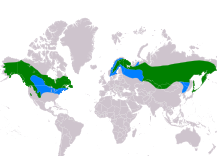| Pine grosbeak | |
|---|---|

| |
| Male | |

| |
| Female in Canada | |
| Scientific classification | |
| Domain: | Eukaryota |
| Kingdom: | Animalia |
| Phylum: | Chordata |
| Class: | Aves |
| Order: | Passeriformes |
| Family: | Fringillidae |
| Subfamily: | Carduelinae |
| Genus: | Pinicola Vieillot, 1808 |
| Species: | P. enucleator
|
| Binomial name | |
| Pinicola enucleator | |

| |
| Breeding range of P. enucleator Resident Non-breeding
| |
| Synonyms | |
|
Loxia enucleator Linnaeus, 1758 | |
The pine grosbeak (Pinicola enucleator) is a large member of the true finch family, Fringillidae. It is the only species in the genus Pinicola. It is found in coniferous woods across Alaska, the western mountains of the United States, Canada, and in subarctic Fennoscandia and across the Palearctic to Siberia. The species is a frugivore, especially in winter, favoring small fruits, such as rowans (mountain-ashes in the New World). With fruit-crop abundance varying from year to year, pine grosbeak is one of many subarctic-resident bird species that exhibit irruptive behavior. In irruption years, individuals can move long distances in search of suitable food supplies, bringing them farther south and/or downslope than is typical of years with large fruit crops.
- ^ BirdLife International (2018). "Pinicola enucleator". IUCN Red List of Threatened Species. 2018: e.T22720625A132141177. doi:10.2305/IUCN.UK.2018-2.RLTS.T22720625A132141177.en. Retrieved 11 November 2021.
